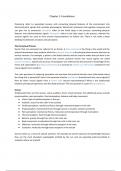Samenvatting
Summary of Sensation and Perception, (Yantis & Abrams, 2017), PSB3E-CP07
- Instelling
- Rijksuniversiteit Groningen (RuG)
This document contains summaries of the relevant chapters of Sensation and Perception for the course 'Perception' at the RUG. Each of the chapters relevant for the course (1, 2, 3, 4, 5, 6, 9, 10, 11, 12, Appendix) are individually summarised.
[Meer zien]





